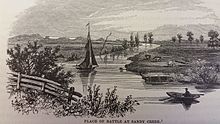Battle of Big Sandy Creek
This article needs additional citations for verification. (December 2008) |
| Battle of Big Sandy Creek | |||||||
|---|---|---|---|---|---|---|---|
| Part of the War of 1812 | |||||||
 Battle of Big Sandy Creek[1] | |||||||
| |||||||
| Belligerents | |||||||
|
|
| ||||||
| Commanders and leaders | |||||||
|
Stephen Popham |
Melancthon T. Woosley Daniel Appling | ||||||
| Strength | |||||||
| 153 marines and sailors |
150 riflemen 125 Indians | ||||||
| Casualties and losses | |||||||
|
13 killed 140 captured (30 of whom were wounded)[2] | 2 wounded[3] | ||||||
The Battle of Big Sandy Creek was fought in northwestern
With the loss of a boat, and its subsequent discovery by British forces, the Americans lost the element of surprise prior to the battle. Nevertheless, the strategy was still implemented successfully, forcing the entire British force to surrender and ending their advance.
Background
After the successful attack on Fort Oswego on May 5–6, 1814, the British withdrew to the Galloo Islands in northern Lake Ontario where they could monitor and intercept any supplies on their way north to Sackets Harbor, New York. At the American ship yards in Sackets Harbor, two brigs, USS Jefferson and Jones, and a frigate, Superior, waited for armament and rigging necessary for their launch. The supplies needed to outfit the ships had been transported from the Brooklyn Naval Yards on Long Island to Albany, New York, and from Albany up the Mohawk River to Wood Creek and Oneida Lake, finally arriving at the Oswego River. These supplies still needed to be transported from Oswego to Sackett's Harbor, but it needed to be done without alerting the British.
On April 21, 1814, Commodore Isaac Chauncey sent orders from Sackets Harbor to Lieutenant Melancthon Taylor Woolsey directing him to choose five officers and twenty-five men to proceed in USS Lady of the Lake to Oswego and then bring the shipbuilding supplies north to the shipyards.[citation needed]
Battle
On the rainy evening of May 28, Woolsey set out with 150
At Big Salmon, the American forces met up with the Oneidas (estimates range from 120 to 130 Indians), who Woolsey had dispatched the previous day. The Oneidas marched north along the shore as the boats proceeded in the lake. At noon on May 29, they reached the mouth of the Big Sandy Creek. All the boats were sent as far inland as possible.[citation needed]
Woolsey then sent a lookout to scout for British ships. The lookout discovered that a gunboat and three barges were headed for the location of the American forces. Woolsey set out a call for the neighboring militia and hastily prepared for battle.
At 8 a.m., the British began to cannonade the American forces from the mouth of the Big Sandy Creek. The American forces hid along the shoreline of the creek and waited for the British to advance inland. At about 10 a.m., when the British forces had progressed up the creek, the American forces rose from their concealment, and a brief ten-minute battle ensued. The British officers quickly surrendered to avoid further casualties.
Losses
The Americans suffered 2 wounded: an Oneida Indian and a U.S. rifleman.[3] Appling wrote to Brigadier General
Aftermath
The Americans won the battle but the British Navy still maintained a presence on Lake Ontario.[4] Overland was the only way for the Americans to get their supplies the rest of the way to Sackets Harbor. Ox carts carried most of the supplies except for the 4-ton anchor cable for the USS Superior.[5] 200 volunteers carried the cable on their shoulders the remaining 20 miles. 100 men at a time shouldered roughly 100 pounds each for three days[6] successfully avoiding the British.[7]
Notes
References
- Brannan, John (comp.). Official Letters of the Military and Naval Officers of the United States During the War with Great Britain in the Years 1812, 13, 14, & 15; with Some Additional Letters and Documents Elucidating the History of That Period. Washington, D.C.: Way & Gideon, 1823. (Library of American Civilization, #14250).
- Chester, Gregory Battle of Big Sandy: War Of 1812 Publisher: George "Greg" Gregory Chester, 2007 http://hasjny.tripod.com/id11.html ISBN 978-0-9791135-0-5
- Fay, Heman Allen (1817). Collection of the Official Accounts, in Detail, of all the Battles Fought by Sea and Land, between the Navy and Army of the United States, and the Navy and Army of Great Britain, During the Years, 1812, 13, 14 & 15. (Library of American Civilization; LAC 12346). New York: E. Conrad.
- Hough, Franklin B. A History of Jefferson County in the State of New York from the Earliest Period to the Present Time. Watertown, NY: Sterling & Ridell, 1854; reprint, Ovid, NY: W.E. Morrison & Co., 1976. 506–511.
- Lossing, Benson John. Pictorial Field Book of the War of 1812: Illustrations by Pen and Pencil of the History, Biography, Scenery, Relics, and Traditions of the Last War for American Independence. New York: Harper Brothers. 1868. (Library of American Civilization #14918-19). 798-801. ISBN 1-58980-002-8
- National Archives Naval Records, Ship Historical Identification Card for SUPERIOR, US Frigate (OPNAV Form 5070-10).
- Niles Weekly Register. June 18, 1814.
- Quimby, Robert S. (1997). The U.S. Army in the War of 1812: An Operational and Command Study. East Lansing, MI: Michigan State University Press. ISBN 0-87013-441-8.
- Slosek, Anthony M. Oswego and the War of 1812. Oswego, NY: Heritage Foundation of Oswego, 1989. ISBN 99927-734-0-5
- Nicolas, Paul Harris (2010) [1845]. Historical Record of the Royal Marine Forces, Volume 2, 1805-1842. BiblioBazaar, LLC. p. 260. ISBN 1142426831.
External links
